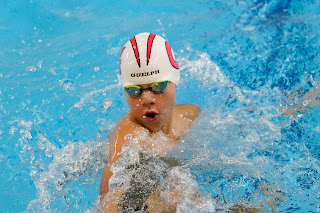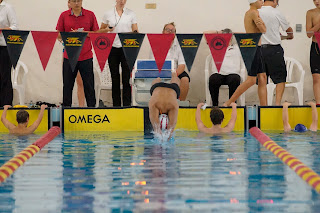Obtaining reasonably good swim photos require two basic things: Access to the deck and freedom to move around, and an expensive camera.
Access and freedom of movement is important because as I will show, different events/strokes require different positioning. With movement, you will require non-slip shoes (water is an occupational hazard, and falling down is made worse if you break your fall with your camera, worse if you hurt someone else) and pants/shirts that you don't mind getting wet.
An expensive camera is crucial because only the pro cameras offer the settings required:1/2000 sec to freeze water drops in mid-air, F4, ISO8000. My Sony a99 is a pro (read: expensive) camera with 5fps and a buffer of 12 jpgs at a time but it was barely able to keep up. I had to anticipate the peak of the action instead of just letting go a burst of 30 frames and hope one will capture the peak. On the positive side, a slow camera trains you to be disciplined with your shot selection. Any camera (and lens) needs to be weather-sealed against the chlorine-tinged environment.
The one lens that worked for the size of the venue (25m Short Course) is a 70-200F2.8 lens. Notice the narrow walkways on either side of the pool.
As for equipment considerations, a two-day Swim Event, shooting a total of 2x 5-hour days could easily yield 6K images (my keeper ratio is 1-in-4), and this is with shooting judiciously. That's a lot of shutter actuations on shutters that are rated for, in my case, 200K (the Sony a99 retails for $2500). Consumer cameras may be rated for 60K. Consumer cameras, and even higher rated (and more expensive) enthusiust cameras are not very good at handling high ISO's (ISO8000 was used for this shoot). Frame rates per second would be lower too.
In other words, shooting is like putting on mileage on a car, a car that won't last for too long.
Swimming is unique in that only the face is visible most of the time. Unlike "dry" sports where the whole body is available. This severely limits the athletic expression that is available to be photograph. There are 4 swim strokes (Breast, Free, Fly, Back), each with their own set of challenges, dependent on the age group, and the distance. In general, younger swimmers have less-developed forms and their heads are submerged more often than not. On the other hand, I imagine their parents would be the most enthusiastic to purchase photos.
Breast stroke is best shot with the swimmer coming towards the camera. On the shortest distance (50m), there is only one chance to take the photos: the first 25m. More developed swimmers may streamline up to 15m of the 25m pool length which means you have 10m worth of shooting time. Less-developed swimmers afford more shooting time. One advantage of shooting the swimmers head on (also applies in the Fly), is that moving sideways to the next lanes provides more opportunities to capture more swimmers.
Freestyle is best shot from the sides, with two chances in the 50m, out and back. Some of the more dramatic shots are in the Freestyle. In the Free, the first three lanes closest to the shooter are prime subjects.
The Fly is treated the same way as the Breast, shot head on. Watch for water splashing!
The Backstroke is difficult to shoot; ideally, it should be shot from the ceiling! In which case, the two lanse closest to the shooter shows the best. This is where the short end of the lens (70mm) is used.
Other points-of-views are sideways on the Breast,
The turn on the Breast and the Fly,
And of course, on the dives.
Finally, also available are the shots of swimmers out of the water, socializing, cheering on teammates, warming up, or deep in concentration for their event.























































